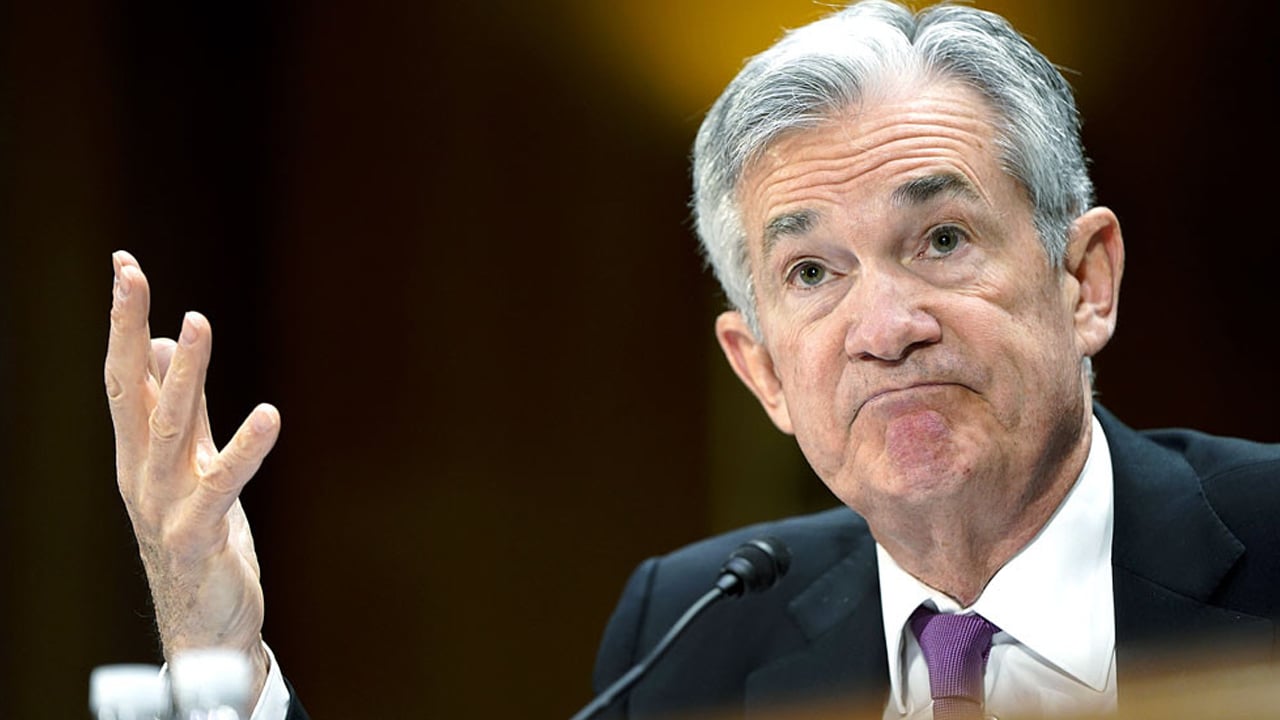 Equities, crypto markets, and precious metals did well during the early morning trading sessions on Wednesday, just before the U.S. central bank wrapped up its Federal Open Market Committee (FOMC) meeting. While the Fed said in a statement that the benchmark interest rate would rise soon, the central bank’s lead Jerome Powell said the committee […]
Equities, crypto markets, and precious metals did well during the early morning trading sessions on Wednesday, just before the U.S. central bank wrapped up its Federal Open Market Committee (FOMC) meeting. While the Fed said in a statement that the benchmark interest rate would rise soon, the central bank’s lead Jerome Powell said the committee […]
Regulatory uncertainty and tighter monetary policies continue to weigh on BTC price, but data shows bulls are attempting to provoke a reversal.
Bitcoin (BTC) investors seem uncomfortable with adding positions after the most recent 40% correction from the $69,000 all-time high made on Nov. 10. In addition to the prolonged downtrend, remarks from the United States Federal Reserve on Dec. 15 about rising interest rates are also weighing on risk-on assets.
The Fed signaled that it could raise its benchmark rate three times this year and there are plans to increase the pace of its asset purchasing taper.
Consequently, traders are worried that these plans will negatively impact traditional and crypto markets because liquidity will no longer be "easily" available.

Cryptoasset regulation in the U.S. has recently been in the spotlight and recently a member of the Securities and Exchange Commission's Investor Advisory Committee called for the agency to open public comments regarding digital asset regulation.
On Jan. 18, associate law professor J.W. Verret addressed the petition to SEC Secretary Vanessa Countryman and according to Verret, the current path the SEC is taking seems not to recognize that digital assets do not fit within the regulatory framework designed for equity investments.
The professor also questioned what requirements the SEC would consider in approving a Bitcoin spot exchange-traded fund.
Even though Bitcoin is said to be correlated to traditional markets, BTC derivatives traders were not expecting sub-$44,000 prices according to the Jan. 21 options expiry. Friday’s $590 million open interest will allow bears to score up to $82 million if BTC trades below $41,000 during the expiry.

At first sight, the $380 million call (buy) options vastly surpass the $210 million put (sell) instruments, but the 1.81 call-to-put ratio is deceptive because the recent price drop will likely wipe out most of the bullish bets.
There is no value in the right to buy Bitcoin at $44,000 if it is trading below that price. Therefore, if Bitcoin remains below $44,000 at 8:00 am UTC on Jan. 21, only $64 million of those call (buy) options will be available at the expiry.
Here are the four most likely scenarios for Friday's $590 million options expiry. The imbalance favoring each side represents the theoretical profit. In other words, depending on the expiry price, the active quantity of call (buy) and put (sell) contracts varies:
This crude estimate considers put options being used in bearish bets and call options exclusively in neutral-to-bullish trades. However, this oversimplification disregards more complex investment strategies.
Regulatory uncertainty and Federal Reserve monetary policies might be reasons for the recent market weakness, but a mere 5% price pump from the current $42,000 level is enough for Bitcoin bulls to profit $103 million in Friday's expiry.
However, if the current short-term negative sentiment prevails, bears could easily pressure the price below $41,000 and pocket $132 million gains.
Currently, options markets data slightly favor the put (sell) options, but the outcome is yet to be seen.
The views and opinions expressed here are solely those of the author and do not necessarily reflect the views of Cointelegraph. Every investment and trading move involves risk. You should conduct your own research when making a decision.

Derivatives analysis suggests that ETH will continue to bounce around in the $3,300 to $3,600 range for the short-term.
Ether (ETH) price has bounced 13% from its Jan. 9 low at $2,950, but it seems premature to call the move a cycle bottom. Instead, the larger bearish movement has prevailed and although it looks primarily correlated to Bitcoin (BTC) price, regulatory concerns and a tighter United States Federal Reserve policy have also been blamed for the movement.
BTC and Ether have been under pressure since regulators focused their attention on stablecoins. On Nov. 1, the U.S. Treasury Department urged Congress to ensure that stablecoin issuers are regulated similarly to U.S. banks.

Currently, the descending channel formation initiated in mid-November shows resistance at $3,850 resistance. The average network transaction fees have also risen back above $50 and the longer that the Ethereum 2.0 upgrade takes to occur, the better the situation will be for competing chains.
Regardless of the rationale behind Ether’s 28% price drop over the past six weeks, bulls missed the opportunity to secure a $300 million profit in the Jan. 14 weekly options expiry. Unfortunately for them, this $4,500 and higher scenario seems unfeasible at the moment.

The call-to-put ratio shows an 89% advantage for bulls because the $380 million call (buy) instruments have a larger open interest versus the $200 million put (sell) options. The current 1.89 measure is deceptive because the recent Ether price drop caused most of the bullish bets to become worthless.
For example, if Ether's price remains below $3,300 at 8:00 am UTC on Jan. 14, only $24 million worth of these call (buy) options will be available, but there is no value in having the right to buy Ether at $3,300 if it is trading below that price.
Related: Cointelegraph Consulting - A look at Terra’s ecosystem
Below are the three most likely scenarios based on the current price action. The number of option contracts available on Jan. 14 for bulls (call) and bear (put) instruments vary depending on the expiry ETH price. The imbalance favoring each side constitutes the theoretical profit:
This crude estimate considers call options being used in bullish bets and put options exclusively in neutral-to-bearish trades. Even so, this oversimplification disregards more complex investment strategies.
For instance, a trader could have sold a put option, effectively gaining a positive exposure to Ether above a specific price. But, unfortunately, there's no easy way to estimate this effect.
Ether bulls would have had a decent $300 million advantage if the price held above $4,500. However, the current scenario requires a 6% positive move from $3,300 to $3,500 to generate a $60 million advantage.
Considering there are less than 12 hours until Jan. 14's options expiry, bulls will likely concentrate their efforts on keeping the price above $3,300 to balance out the scales.
The views and opinions expressed here are solely those of the author and do not necessarily reflect the views of Cointelegraph. Every investment and trading move involves risk. You should conduct your own research when making a decision.

Derivatives data suggests that sentiment-wise, pro traders are still neutral on Bitcoin’s price prospects ahead of Friday’s $750 million options expiry.
Bitcoin (BTC) has bounced 11% from the $39,650 low made on Jan.10 and currently the price is battling with the $44,000 level. There are multiple explanations for the recent weakness, but none of them seem sufficient enough to justify the 42% correction that took place since the Nov. 10 all-time high at $69,000.
At the time (Nov. 12), negative remarks from the U.S. Securities and Exchange Commission (SEC) were issued at the rejection of VanEck's physical Bitcoin exchange-traded fund (ETF). The regulator cited the inability to avoid market manipulation due to unregulated exchanges and heavy trading volume based on Tether's (USDT) stablecoin.
Then, on Dec. 17, the U.S. Financial Stability Oversight Council recommended that state and federal regulators review regulations and the tools that could be applied to digital assets. On Jan. 5, BTC price corrected again after the Federal Reserve's December FOMC session, which confirmed plans to ease debt buyback and likely increase interest rates.
Regarding derivatives markets, if Bitcoin price trades below $42,000 by the Jan. 14 expiry, bears will have a $75 million net profit on their BTC options.

At first sight, the $455 million call (buy) options are overshadowing the $295 million puts, but the 1.56 call-to-put ratio is deceptive because the 14% price drop over the last three weeks will likely wipe out most of the bullish bets.
If Bitcoin's price remains below $44,000 at 8:00 am UTC on Jan. 14, only $44 million worth of those call (buy) options will be available at the expiry. There is no value in the right to buy Bitcoin at $44,000 if BTC is trading below that price.
Here are the four most likely scenarios for the $750 million options expiry on Jan. 14. The imbalance favoring each side represents the theoretical profit. In practice, depending on the expiry price, the quantity of call (buy) and put (sell) contracts becoming active varies:
This crude estimate considers put options being used in neutral-to-bearish bets and call options exclusively in bullish trades. However, this oversimplification disregards more complex investment strategies.
For instance, a trader could have sold a put option, effectively gaining a positive exposure to Bitcoin (BTC) above a specific price. But, unfortunately, there's no easy way to estimate this effect.
Related: Traders say Bitcoin run to $44K may be a relief bounce, citing a repeat of December’s ‘nuke’
The only way bulls can score a significant gain on the Jan. 14 expiry is by sustaining Bitcoin's price above $46,000. However, if the current short-term negative sentiment prevails, bears could easily pressure the price down 4% from the current $43,800 and profit by up to $75 million if Bitcoin price stays below $42,000.
Currently, options markets seem balanced, giving bulls and bears equal odds for Friday's expiry.
The views and opinions expressed here are solely those of the author and do not necessarily reflect the views of Cointelegraph. Every investment and trading move involves risk. You should conduct your own research when making a decision.

Key BTC trading metrics are sitting on the edge of the “worst outcome” scenario, suggesting that the current sell-off is far from over.
Bitcoin (BTC) briefly reached its lowest level in five months this Monday at $39,650, marking a 42.6% drawdown from the all-time high present on Nov 22, 2022. Some argue that a “crypto winter” has already begun citing the $2.1 billion leverage-long aggregate crypto futures contracts that were liquidated over the past seven days.

The descending channel guiding Bitcoin’s negative performance for the past 63 days indicates that traders should expect sub-$40,000 prices by February.
Confidence from investors continued to decline after the United States Federal Reserve’s December FOMC session on Jan. 5. The monetary policy authority showed commitment to decrease its balance sheet and increase interest rates in 2022.
On Jan. 5, Kazakhstan’s political turmoil added further pressure to the markets. The country’s internet was shut down amid protests and this caused Bitcoin’s network hashrate to tumble 13.4%.
To analyze how bullish or bearish professional traders are, one should monitor the futures premium , which is also known as the “basis rate.”
The indicator measures the difference between longer-term futures contracts and current market levels. A 5% to 15% annualized premium is expected in healthy markets, which is a situation known as contango.
This price gap is caused by sellers demanding more money to withhold settlement longer and a red alert emerges whenever this indicator fades or turns negative, which is a scenario known as “backwardation.”

Notice how the futures market premium did not trade below 7% over the past couple of months. This is an excellent indicator considering the absence of Bitcoin price strength during this period.
To exclude externalities specific to the futures instrument, one should also analyze the options markets.
The 25% delta skew compares similar call (buy) and put (sell) options. This metric will turn positive when fear is prevalent because the protective put options premium is higher than similar risk call options.
The opposite holds when greed is the prevalent mood which causes the 25% delta skew indicator to shift to the negative area.

Readings between negative 8% and positive 8% are usually deemed neutral. The last time the 25% delta skew indicator entered the “fear” range at 10% was on Dec 6, 2022.
Related: Bitcoin drops below $40K for first time in 3 months as fear set to 'accelerate'
Thus, options markets’ traders are at the very edge of the neutral-to-bearish sentiment because the indicator currently stands at 8%. Moreover, buying protective put options is becoming more expensive, so market markers and arbitrage desks are not confident that $39,650 was the bottom.
Overall, the sentiment is pessimistic and the $2.1 billion in aggregate futures contracts liquidations signal that derivatives traders’ longs (buyers) are quickly losing confidence. Only time will tell where the exact bottom is, but presently, there is not an indication of strong support coming from pro traders.
The views and opinions expressed here are solely those of the author and do not necessarily reflect the views of Cointelegraph. Every investment and trading move involves risk. You should conduct your own research when making a decision.
 Global markets have defied predictions as the U.S. Federal Reserve and several central banks worldwide are prepping to slow down monetary easing policy. On Wednesday, the U.S. central bank’s Federal Open Market Committee (FOMC) said it plans to taper quantitative easing (large monthly asset purchases) and end the program by March 2022. Moreover, the FOMC […]
Global markets have defied predictions as the U.S. Federal Reserve and several central banks worldwide are prepping to slow down monetary easing policy. On Wednesday, the U.S. central bank’s Federal Open Market Committee (FOMC) said it plans to taper quantitative easing (large monthly asset purchases) and end the program by March 2022. Moreover, the FOMC […]
Bitcoin, altcoins and stocks rallied shortly after the Fed laid out its policy roadmap for 2022, but bears still have an advantage in this week $755 million options expiry.
Bitcoin's (BTC) price has been in a down-trend since the $69,000 all-time high on Nov. 10, when the the Labor report showed inflation pushing above 6.2% in the United States. While this news could be beneficial for non-inflationary assets, the VanEck physical Bitcoin exchange-traded fund (ETF) denial by the U.S. Securities and Exchange Commission (SEC) on Nov. 12 threw some investors off-guard.

While the ETF request denial was generally expected, the reasons given by the regulator may be worrisome for some investors. The U.S. SEC cited the inability to avoid market manipulation on the broader Bitcoin market due to unregulated exchanges and heavy trading volume based on Tether's (USDT) stablecoin.
Analyzing the broader market structure is extremely relevant, especially considering that investors closely monitor meetings held by the U.S. Federal Reserve. Regardless of the magnitude of the upcoming tapering in the Fed's bond and assets repurchase program, Bitcoin's movements have been tracking the U.S. Treasury yields over the past 12 months.

This tight correlation shows how decisive the Federal Reserve's monetary policy has been with riskier assets, including Bitcoin. Moreover, the yield decline over the past three weeks from 1.64 to 1.43 partially explains the weakness seen in the crypto market.
Obviously, there are cother factors in play, for example, the market pullback on Nov. 26 was primarily based on concerns over the new COVID-19 variant. Regarding derivatives markets, a Bitcoin price below $48,000 gives bears complete control over Friday's $755 million BTC options expiry.

At first sight, the $470 million call (buy) options overshadow the $285 million put (sell) instruments, but the 1.64 call-to-put ratio is deceptive because the 14% price drop since Nov. 30 will likely wipe out most of the bullish bets.
If Bitcoin's price remains below $49,000 at 8:00 am UTC on Dec. 17, only $28 million worth of those call (buy) options will be available at the expiry. In short, there is no value in the right to buy Bitcoin at $49,000 if it is trading below that price.
Here are the three most likely scenarios for the $755 million Friday's options expiry. The imbalance favoring each side represents the theoretical profit. In other words, depending on the expiry price, the quantity of call (buy) and put (sell) contracts becoming active varies:
This crude estimate considers call options being used in bullish bets and put options exclusively in neutral-to-bearish trades. However, this oversimplification disregards more complex investment strategies.
For instance, a trader could have sold a put option, effectively gaining a positive exposure to Bitcoin (BTC) above a specific price. But, unfortunately, there's no easy way to estimate this effect.
The only way for bulls to avoid a significant loss in the Dec. 17 expiry is by sustaining Bitcoin's price above $48,000. However, if the current short-term negative sentiment prevails, bears could easily pressure the price down 4% from the current $48,500 and profit up to $105 million if Bitcoin price stays below $47,000.
Currently, options markets data slightly favor the put (sell) options, thus creating opportunities for additional negative pressure.
The views and opinions expressed here are solely those of the author and do not necessarily reflect the views of Cointelegraph. Every investment and trading move involves risk. You should conduct your own research when making a decision.

Commentators brace for upheaval as Fed officials prepare to reveal future financial policy moves.
Bitcoin (BTC) sought cues from the United States Federal Reserve on Dec. 14 as markets waited anxiously for news on policy.

Data from Cointelegraph Markets Pro and TradingView showed BTC/USD continuing in a range around $47,000 as Wall St. opened on Dec. 15.
The pair had hit local highs of $48,785 on Bitstamp overnight but was down 3% at the time of writing ahead of a key Fed meeting.
The Federal Open Market Committee (FOMC) will begin discussions at 2 pm Eastern Time, with expectations focusing on interest rates, inflation and asset purchase tapering.
A hawkish stance is foremost in analysts' minds, this potentially causing pain for risk asset holders in the short term should the Fed's approach become less liberal.
"Markets are forward-looking. Crypto is even more so because it's not under anyone's control. It's the only free market left in the world," popular crypto trader Pentoshi summarized in a Twitter discussion on the issue.
"The Fed is still adding to it's balance sheet but at a decreased rate. Smart money prepped last month. Slow money this week."
Traditional markets were similarly directionless, with the S&P 500 down 0.22% on the day.
As Cointelegraph reported, with Bitcoin underperforming compared to what many assumed Q4 2021 would look like, a consensus is building that 2022 will form the market cycle peak for both BTC and altcoins.
"The panic & bearish sentiment towards BTC is extreme right now. But there’s nothing extreme about this -38% retrace," fellow trader and analyst Rekt Capital reiterated.
"Over the years, BTC has retraced 30–40% many times in Bull Markets. In fact, $BTC retraced -53% this past May -38% isn’t extreme."
Rekt Capital previously noted that a close above $42,300 still represents a higher low formation for BTC/USD.
On altcoin markets, the mood was more pronounced in its skew to the downside.
Related: Bitcoin sheds ‘dumb money’ as retail buys most BTC since March 2020 crash
Out of the top ten cryptocurrencies by market cap, all except Solana (SOL) were mildly in the red on daily timeframes.
Dogecoin (DOGE), fresh from its Tesla publicity, managed to secure around half of its 25% gains.
"Right now, people are easily selling their bags as they are convinced a huge drop will happen tonight," Cointelegraph contributor Michaël van de Poppe argued.
The Crypto Fear & Greed Index stood at 28/100, up from 21/100 on Tuesday, marking a transition from "extreme fear" to "fear" within its own range reflective of Bitcoin's recent moves.


On Tuesday, SEC Chair Gary Gensler re-confirmed his plan to crack down on cryptocurrencies, and traders’ regulatory concerns are confirmed by this key Bitcoin futures and options indicator.
After 46 consecutive days of trading above $42,000, Bitcoin (BTC) price started to show weakness on Sept. 21. Over the last three days, the 13% accumulated loss was enough to erase the hard-earned gains added since Aug. 6. Historicals also show that the previous bearish cycle took 79 days to regain the all-important $42,000 level.
Traders' attention turned to the start of the U.S. Federal Reserve's monetary meeting, where the financial authority is expected to indicate whether it will curtail the $120 billion monthly asset repurchase stimulus program. Curiously, as all this takes place, China's equity markets, as measured by the iShares MSCI China ETF ($MCHI), rebounded 1% on Sept. 21.
The apparent disconnection between Bitcoin's performance and the global markets' slight recovery caused investors to question whether cryptocurrency regulation is playing a role in the current bearish scenario.
Today U.S. Securities and Commission (SEC) Chair Gary Gensler spoke to the Washington Post, and during the interview, he called stablecoins instruments for use at the "casino gaming tables."
Groan. The US regulatory clampdown on crypto which has been brewing the past six months just looks like it’s going to get uglier & uglier with each passing week. Not even sure what impact it’s going to have on the markets, but there sure isn’t much to be optimistic about rn.
— Grant Gulovsen, Esq. (@gulovsen) September 19, 2021
As noted by the attorney Grant Gulovsen, the looming shadow of regulation is expected to have a short-term bearish impact, and investors in any market hate uncertainties regarding what products and services will be allowed.

Notice how the $42,000 level was crucial in determining the end of the mini-bear cycle that was supposedly initiated by Elon Musk's remarks on Bitcoin mining energy use on May 12.
To effectively measure how professional traders are pricing the risk of the further price collapse, investors should monitor the 25% delta skew, which compares similar call (buy) and put (sell) options side-by-side. It will turn positive when the protective put options premium is higher than similar risk call options.
A skew indicator oscillating between -7% and +7% is usually deemed neutral. On the other hand, the metric shifts above this range whenever the downside protection is more costly, typically a "fear" indicator.

As shown above, Bitcoin options traders have been neutral since July 25, when the indicator dropped below the 7% threshold. However, the recent price action caused shorter-term options traders to enter "fear" mode after the metric reached 9%.
To exclude externalities specific to this options instrument, one should also analyze the perpetual futures markets.
Unlike regular monthly contracts, perpetual futures prices are very similar to those at regular spot exchanges. This feature makes retail traders' lives a lot easier because they no longer need to calculate the futures premium or manually roll over positions near expiry.
The funding rate was introduced to balance the exchange's exposure and it is charged from longs (buyers) when they are demanding more leverage. However, when the situation is reversed and shorts (sellers) are over-leveraged, the funding rate goes negative, so they become the ones paying the fee.

The chart above shows that Bitcoin's funding rate has constantly shifted to the negative side, despite not being sustainable or relevant. For example, a 0.05% rate charged every 8 hours is equivalent to 1% per week, which shouldn't force any derivatives trader to close their position.
Therefore, options markets data validates the "fear" indicator coming from the positive 25% delta options skew. There is a lack of conviction from buyers using derivatives markets, which is likely related to the recent negative regulatory concerns. The latest victim to regulatory pressure came from Coinbase exchange's decision to avert plans for offering a crypto lending program.
The views and opinions expressed here are solely those of the author and do not necessarily reflect the views of Cointelegraph. Every investment and trading move involves risk. You should conduct your own research when making a decision.